M. Isidora Forrest's Blog, page 44
July 4, 2014
Isis & Her Dark Twin, Nephthys
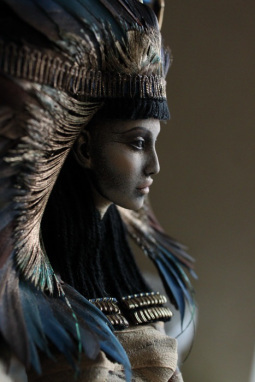
A stunning modern Nephthys by—appropriately—a pair of artist sisters, Katya and Lena Popovy
Older Egyptological books informed us that Nephthys was never worshipped alone and had no temples of Her own.
But that was only because they hadn’t found any yet.
Thankfully, we now know of several Nephthys temples, a smaller New Kingdom one within a Set temple precinct at Sepermeru, halfway between Heracleopolis and Oxyrhynchus (where that huge cache of texts, including magical texts and a praise of Isis was found), and a Ptolemaic and Roman-era temple at Komir, near Esna.
In Her Komir (Egy. Pr Myr) temple, there is a lengthy hymn to Her that identifies Her with many other Goddesses, just as Isis is known by many names. She is “the Great, the Most Excellent, dwelling in the Beautiful Country—the abode of Her brother Osiris, Who comes to life again in Her, She Who renews for Him the body that once was, in Her name of Renewing of Life.” She is invoked as Meshkenet, the Birth Goddess, Hathor, Mistress of Drunkeness and Joy, Tefnut “in the moment of Her wrath,” and Seshet, Lady of Writing and “of the Entire Library.” She is Mut and Mafdet and Meret and Heket. She is the one Who “utters divine decrees, Great of Magic, who rules in the Mansion of Archivists.” She is Excellent of Kindness and unites Herself with Ma’et. She is the Mother of Amun and the Daughter of Re. She is Mighty, Formidable, Beautiful.
In a papyrus known as the Book of Hours—Ptolemaic and probably from Memphis—praises are recorded for a select group of Deities, including Nephthys. There She is called Kindly of Heart, Mistress of Women, the Valiant, the Strong-Armed, Who Begat Horus, Potent of Deeds, the Wise, the Acute of Counsel, and the Sad at Heart.
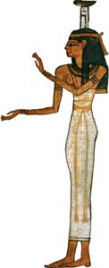
Nephthys, the Lady of the Temple
Interestingly, Her epithets in this papyrus do not parallel those of Isis, Who is In All that Comes Into Being at Her Command, Lady of What Exists, Sharp of Flame, Who Fills the Land with Her Governance, Who Pleases the Gods with What She Says, the Savior, Isis-Bast and Isis-Sakhmet, the Sister of the Great One, Who Comes at Call, and the Living North Wind.
As Twin Goddesses, Isis and Nephthys are often called “the two” this or that. You’ll find a list of those twosome names in a previous Isis and Nephthys post here. We often think of Isis as the Bright Twin and Nephthys as the Dark Twin. And it’s true. Sort of.
For instance, the Pyramid Texts instruct the deceased king to
Ascend and descend; descend with Nephthys, sink into darkness with the Night-barque. Ascend and descend; ascend with Isis, rise with the Day-barque. (Pyramid Text 222)
The Two Goddesses bear light and dark children to the same God. Osiris fathered the bright God, Horus, with Isis while with Nephthys, He fathered the dark God, Anubis. The Two Goddesses also manifest their Divine power differently. While Isis guides and sheds light on the hidden paths of the Otherworld, the Coffin Texts tell us that Nephthys speaks and they are obscured: “Hidden are the ways for those who pass by; light is perished and darkness comes into being, so says Nephthys.”
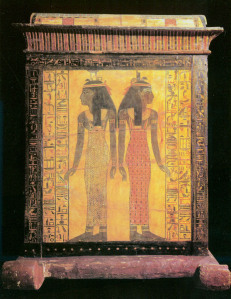
The Two Sisters protect the deceased
While Isis summons the Barque of the Day, Nephthys is “a possessor of life in the Night-barque.” As in Pyramid Text 217, Nephthys is paired with Set, a God of dark moods and dark reputation and associated with Upper Egypt, while Isis is paired with the benevolent God Osiris and connected to Lower Egypt. In the tomb of Tuthmosis III, Nephthys is said to be the Lady of the Bed of Life, by which was meant the embalming table. She is also Queen of the Embalmer’s Shop. Plutach preserves the tradition that Nephthys was associated with the desert and the fringes of the earth, while Isis is that part of the earth made fertile by the Nile.
But wait. As with most Things Egyptian, it’s not that simple. It’s not that black-and-white nor dark and light.
Isis is not just about rebirth and sunrise. She is also the Great Mooring Post, the one Who calls each of us to our deaths. She is the Goddess “ruling in the perfect blackness” of the Otherworld and She has Her own wrathful and fiery moods. Nephthys, on the other hand, is not only about descent in the Night-barque. She is right there with Isis at the sunrise rebirth. And She is a Goddess for Whom festivals of drunkenness and joy were celebrated. She is the Lady of Beer and while Isis, too, can be so called, I know of no festivals of Divine inebriation celebrated for Her, even given Her close connection to Hathor, the original Queen of Divine Drunkenness.
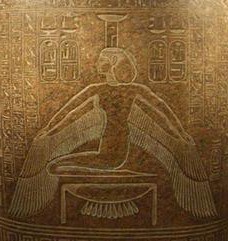
Nephthys in Her protective stance, a mirror of Isis
The Two Sisters are not so much opposites as complements to each other. It is interesting that Isis and Nephthys seem to have become attached to different aspects of Hathor in Their association with Her. Sad at Heart Nephthys became connected with Hathor, Lady of Joy and Divine Intoxication. Lady of Governance Isis became connected with Hathor the soft-eyed Cow Mother, the Mother of the God, and the Lady of Amentet. Yet, as always, these roles are fluid and the Two Sisters flow into one another, even as They express different aspects of Their Divinity.
So are Isis and Nephthys two different Goddesses or one Goddess? Yes. And no. And of course, I know that doesn’t answer the question. They are One and They are Two. In my personal work with the Two Sisters, I can’t say that Nephthys feels very much different than Isis, but that may be because I pay a lot of attention to Isis’ own darker aspects. But that admission inspires me to take some time this holiday weekend to honor Nephthys, Excellent of Kindness, and see what more She may wish me to know.
Filed under: Goddess Isis Tagged: Deities, Egypt, Egyptian magic, Goddess, Goddess Isis, Goddess worship, Isis, Isis & Nephthys, Isis Magic, Isis worship today, Nephthys, The Two Goddesses








June 28, 2014
Iset Sopdet & Nuet

That’s Sirius at the bottom of the picture, framed by the trees. To day, I haven’t found a convenient calculator for discovering when She rises in your area. If you have, let me know. Probably the most accurate method is given here. But there’s also an interesting visualizer here.
She is hidden now.
At least here on the west coast of the US, the beautiful Star of Isis (Sopdet in Egyptian, Sothis in Greek, Sirius in Latin) cannot now be seen in the night sky. She won’t be visible until later in August. When She first reappears in your area depends on your latitude; the further south you are, the earlier She is visible. For me, Sirius will be above the horizon for about a minute before the light of the sun obscures the starlight on August 13-14. However, I probably won’t be able to see it (there are significant trees on my horizon) until some few days after that, when Sirius rises earlier and the sun rises later.
But now, at the end of June, Iset Sopdet, Isis the Star Goddess remains hidden.
For the ancient Egyptian, the time before the rising of Sopdet was the end of the year. Then, when Sopdet was observed rising before the Sun God Re in the dawn sky, the New Year arrived and the renewing Inundation, the Nile flood, would soon follow. Isis Sopdet was called The Fair Star of the Waters and its rising meant food for the people.
Few of us have an Inundation to await these days; not even Egyptians, for the river dams now control the waters. And perhaps our own calendrical New Year may hold more potency for us than a late summer New Year. So how can we honor Isis in the hot, dry months of summer?

A most beautiful Nuet; I do not know who’s art this is…can you identify it?
Perhaps we can look at another ancient Egyptian event tied to the rising of Sopdet: the celebration of the birthdays of Osiris, Set, Horus, Isis, and Nephthys. The Deities were said to be born on the five days at the end of the year that were “outside of time.” So at this time, before the rising of Sopdet, we may consider Isis to be within the womb of Her Divine Mother Nuet.
While I have no declared priestesshood for Nuet, She draws me. A lot. In fact, almost anytime I do spiritual work with Her, I am overawed by Her Eternity, Her Depth, Her Beauty, and I want to lose myself in Her.
Nuet is the mother of Isis. She is also called the Mistress of All and the One Who bears the Gods and Goddesses. She is the Splendid and Mighty One in the House of Her Creation. She is the Great One in Heaven and the “indestructible stars” (that is, the circumpolar stars that are always visible) are said to be in Her. She embraces the deceased king and each of us “in Her name of Sarcophagus” and “in Her name of Tomb.” She is the Mistress of the Secret Duat (the Otherworld). She is the Glowing One (perhaps as the Milky Way) and in Her we are joined to our stars, Becoming divine. She is the one Who gives birth to us and Who welcomes us back into Her starry body at our deaths. She is Heaven and She is the Otherworld. She gives birth to the Sun God Re each day and receives him back into Her body, by swallowing, each night. She is the one Who is “Amid the Iset Temple in Dendera” for She is over Her daughter and Her daughter is in Her.
When Isis is in Her mother’s womb, She is also in the Otherworld for Nuet is the Lady of the Duat and Her body is both the Heavens and the Underworld. So now in the heat of the year, our Goddess is in the cool depths of Eternity. Perhaps this is the time for us, as Her devotees, to enter the Otherworld as well. It may even be a particularly safe time to do so for now we have the support of Isis Who awaits us there. If we have scary things to face in our own personal Underworlds, now is a more supportive time to do so. The light of dawn comes more quickly now and the sunlight of Isis the Radiant One is more readily available to us after we have faced those inner darknesses that we must face in order to grow.

Nuet, Lady of Heaven and the Underworld
This may also be a good time to explore our relationships with our mothers. A strong priestess of my acquaintance, who was serving as a Priestess of Nuet at a festival not long ago, told me an interesting thing about how she perceived the relationship between Nuet and Isis. It was her distinct impression that Nuet did not get along with Her daughter. Of course, in the human realm, this is far from an uncommon thing. Mothers and daughters (and mothers and sons, for that matter) can have issues. Now, with the light of summer and the help of the Goddesses available to us, might be a time to shed some light on those issues.
But even if we don’t have mom stresses, this can be a time to honor our mothers, both human and Divine—perhaps under a star-filled sky. Since my own mother has already been enfolded in the wings of Isis, I shall plan to honor my Divine Mother Nuet and Her Starry Daughter, Isis…on the next clear and starry night.
Filed under: Goddess Isis Tagged: Egyptian magic, Goddess, Goddess Isis, Goddess Nuet, Goddess Nuit, Goddess Nut, Goddess worship, Isis and Nuet, Isis Magic, Isis worship today, Mother Goddess, Summer Goddess








June 24, 2014
Thank you, Pagan Federation
I generally do not post anything political on this blog. But I must admit that my stomach has been churning with each newscast I listen to because it is inevitable that I will hear the name of my Goddess used as the name of a terrorist group.
So I applaud the action taken by the UK’s Pagan Federation to ask news outlets to spell out the initials of the I-S-I-S or I-S-I-L rather than saying “Isis.” In fact, I had been thinking of doing something similar. So thank you, Pagan Federation.
Unfortunately, it doesn’t seem to be getting much traction; the Huffington Post apparently thought it was kinda cute that “Pagans are really annoyed…”
Naturally, I did ask Her about it.
She figures She can outlast it.
And, of course, She can.
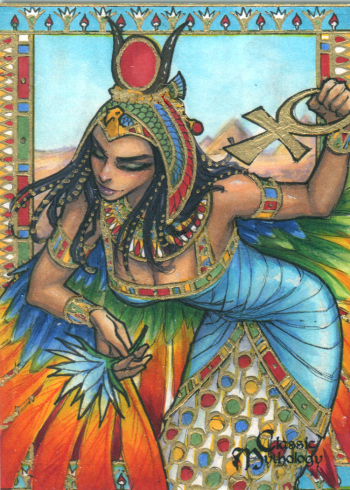
A modern Isis by Meghan Hetrick from the Classic Mythology series.
I missed this past weekend’s post as I was out celebrating the Solstice. I hope yours was bright and beautiful. Next weekend, back to more interesting subjects, I promise.
Filed under: Goddess Isis Tagged: Goddess Isis, Pagan Federation








June 15, 2014
Isis & Thoth
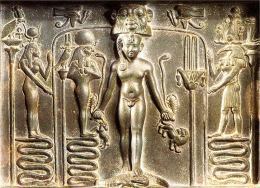
Isis & Thoth (far left and right) add Their magic to Horus’ on the famous Metternich Stele
Ancient Egypt’s two Great Divine Magicians are Isis and Thoth.
Interestingly, both went on to have rather illustrious careers outside Their native Egypt as key players in the Western Esoteric Tradition; Isis as THE quintessential Goddess of esotericism, Thoth as Hermes Trismegistos, THE quintessential teacher of esoteric wisdom.
In fact, the two Divine Magicians have always had a close relationship. Although in earlier Egyptian tradition, Isis is the daughter of Geb and Nuet, Earth God and Sky Goddess, by Plutarch’s time (1st century CE) he is able to say that “many have related that she is the daughter of Hermes,” that is, of Thoth. One inscription calls Her the “vizier and daughter of Thoth.” J. Gwyn Griffiths, one of my favorite scholars, says the two Deities were probably thought to have a family relationship because both were known to be exceptionally wise.
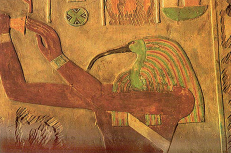
Thoth, Thrice Great
A Hermetic aside
You may be wondering about that Thoth-Hermes connection. How did the Egyptian Thoth and the Greek Hermes become identified? At first glance, it may not seem like They have a lot in common. But not so fast. An important first point of contact is Their connection with souls. Hermes is the psychopomp of the dead, guiding them to the realm of the dead. Thoth, too, is a guide of the dead and takes part in the vital post mortum judgment. Both Gods are associated with the moon and medicine (remember Hermes’s staff the caduceus), and both are known for inventiveness and trickery. The syncretism of Thoth and Hermes eventually resulted in the God/Teacher Hermes Trismegistos, which is an epithet Hermes gets directly from Thoth. In an effort to express Thoth’s majesty, when writing His name Egyptian scribes would often append the epithet Ao, Ao, Ao (literally “Great, Great, Great,” meaning “Greatest”). Greeks and Greek-speaking Egyptians translated the Egyptian epithet as Trismegistos, also using it for ‘their’ Thoth—Hermes. (An excellent book about Hermes Trismegistos’ Egyptian background is Garth Fowden’s The Egyptian Hermes.)
Now back to Isis & Thoth
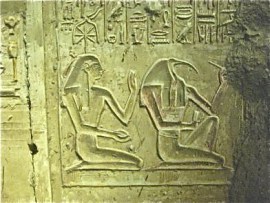
Thoth & Seshat, the Lady of Books
As noted earlier, the two are linked by Their wisdom. This wisdom, in turn, empowers Their magic. In fact, both work Their magic similarly—primarily by speaking. The words of Isis “come to pass without fail;” the words of Thoth are “Truth.” At Busiris, Isis is even called Djedet Weret, the Great Word, no doubt because of Her magical ability with words. Both are associated with the wisdom and magic of books. Thoth is the patron of scribes and the Divine author of all books. Isis and Thoth together are credited with invention of hieroglyphic and demotic writing in several of the Isis aretalogies. The Cairo calendar calls Isis “provider of the book” and the Oxyrhynchus aretalogy notes Her skill in writing. And, as She is with so many Goddesses, Isis is sometimes assimilated with Seshat, Goddess of Writing.
Both Isis and Thoth are Bird Deities. Thoth is so identified with His sacred bird, the ibis, that He never goes anywhere without His bird head. Some scholars think that his Egyptian name, Djehuty, may come from a very ancient form of the Egyptian word for ibis: djhw. If so, this would speak to the ancient nature of Thoth. Isis, of course, is associated with Her sacred raptor, the kite, and sometimes takes on birdform, through She never appears with just the head of a kite as Thoth does with the ibis.
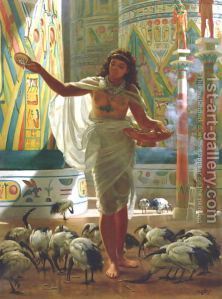
Edward John Poynter: Feeding the Sacred Ibis in the Halls of Karnac
In the ancient world, wisdom could also be expressed in cleverness and even trickery. Both Isis and Thoth can be tricky. In the story of Thoth and Tefnut, Thoth calms the angry Goddess and lures Her back to Egypt by telling Her amusing stories all the while bringing Her closer and closer to home. In the story of the birth of Isis, Osiris, Nephthys, Set, and Horus told by Plutarch, Thoth plays a game with the Moon and wins five extra days in the year during which Nuet can give birth to Her children. The myths of Isis have Her tricking Set time and again to ensure that Horus gets His throne.
One very interesting aspect of the relationship between Isis and Thoth is that Isis often comes to Thoth for help. In the tale of the “Sufferings of Isis,” Isis has been imprisoned by Set in a spinning house. Thoth finds Her and counsels Her (counseling is one of Thoth’s key functions) to escape with Horus to the papyrus swamps, which She does. During the course of the tale, Isis cures the village headwoman’s son of poisoning from seven magical scorpions. (The scorpions were traveling with Isis and got pissed when the headwoman wouldn’t allow the Goddess with Her seven rather scary scorpions in.) Later in the tale, Isis own son, Horus, is poisoned by a scorpion sent by Set and Isis stops the Boat of the Sun to receive magical aid from Thoth.
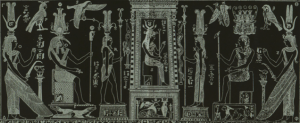
Isis (in center) of the Bembine Tablet; Thoth, (second from left) has Her back as always
One of the Graeco-Egyptian magical papyri (PGM IV. 94-153) has Isis running to “Ape Thoth, Ape Thoth, my father” in tears because of the adultery of Osiris and Nephthys. It is the beginning of a compulsive erotic spell that (apparently) Thoth is giving to Isis so that She can make Osiris return to Her. Another papyri text (PGM VIII. 1-63) invokes Hermes saying, “Whereas Isis, the greatest of all the gods, invoked you in every crisis, in every district, against gods and men and daimons, creatures of water and earth and held your favor, victory against gods and men and [among] all the creatures beneath the world, so also I, [name of the person invoking], invoke you.”
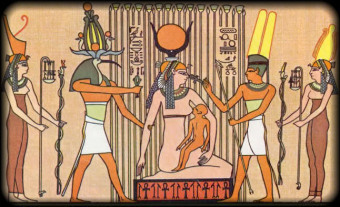
Thoth aids Isis & Horus in the papyrus swamps
I have often wondered why Isis, Great of Magic, Lady of Words of Power, Greatest of All the Gods, Who Knows Re by His Own Name, would need anyone else’s magical assistance. Perhaps the Thoth-Isis relationship goes back further than we have record of it. If Thoth were the elder Magician, it would make sense to call upon His experience. If Thoth can be considered Her father, calling on Dad for help makes sense, too. Or perhaps we’re seeing an ancient version of something still current among some today. For instance, some say that you shouldn’t do a divination for yourself; you’ll skew the results by being personally involved. Sometimes healers can have trouble healing themselves when they are perfectly wonderful when healing others. Some psychologists, those modern-day shamans, can be perfectly terrible at dealing with their own issues while being a great help to others.
Maybe that’s what’s going on in these tales. Sometimes you need a little distance to see clearly—or magically, in this case. It is always during a personal crisis that Isis calls upon Thoth. When Horus is poisoned, Isis is completely distraught and declares that “my heart is adrift.” In such a state, She is not Her magical self. She needs help. As we all do from time to time. In such times, is is well to have friends to call upon as Isis does in Her great friend Thoth.
Filed under: Goddess Isis Tagged: Divine Magicians, Earth and Sky, Egyptian magic, Goddess Isis, Hermes & Thoth, Hermes Trismegistos, I love Isis, Isis, Isis & Thoth, Isis Magic, J. Gwyn Griffiths, Lady of Books, Sacred Ibis, Thoth








June 8, 2014
So how did the worship of Isis spread throughout the ancient world?
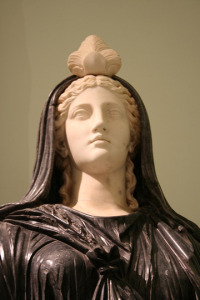
Roman Isis, from the 2nd century CE, in the Farnese Collection in Naples. Image copyright Forrest 2009.
Statisticians will do the darndest things.
I just read an article that was a statistical analysis of the conditions that aided in the spread of the worship of Isis from Egypt into the wider Mediterranean world. The period we’re talking about here is roughly from the second century BCE to the second century CE, a period of about 400 years.
Yeah, I know; boring.
Well, much of it, yes. But there is something in it of interest to Isis devotees, which I’ll get to in a moment. First a quick summary.
You’re probably well aware of how, during the time period we’re talking about, the worship of Isis grew out of Egypt and flourished in the nations bordering the Mediterranean Sea, eventually being carried into Europe. Today, there is hardly anywhere on earth that educated people don’t know the name of Isis. Indeed, I am constantly amazed at how often Her name, or an acronym of it, is used for everything from scientific journals to women’s outdoor clothing to (horribly; please stop, please stop) a terrorist group.
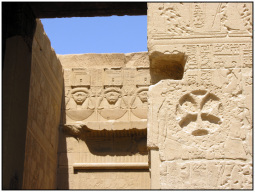
Christian symbols carved on the walls of Isis’ temple at Philae
During this ancient period of the diffusion of Her worship, at least 35 new sanctuaries for Her were constructed. And those are only the ones of which we’re found evidence. Egyptologist Laurent Bricault (who is on academia.com, by the way) made an atlas of Isis sanctuaries at the time and found 167 of them in Africa, Palestine, Syria, Asia Minor, Greece, Italy, Gaul, the Balkins, Britain and Spain.
Scholars often note that Her worship particularly appealed to women, yet merchants, sailors, and soldiers (most of whom were, presumably, men) were important in spreading Her cult. It’s probably more accurate to say that the worship of Isis appealed—and still appeals—strongly to both women and men.
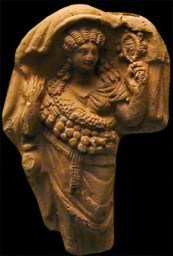
This terracotta of an Isis devotee is Roman, but made in Egypt; now in London in the British Museum. Credits: Barbara McManus, 2001
The author of the statistical study, Robert A. Wortham, identified four hypotheses he wanted to test. They are:
• That Isis temples were established earlier in larger cities
• That Isis temples were established earlier in urban locations closer to Rome
• That Isis temples were established in urban centers with high degrees of religious pluralism
• And that (here’s the interesting one, folks) the diffusion of the Isis cult and the diffusion of Christianity were intertwined
Here’s what he found:
While Isis was indeed worshipped in larger cities, the statistics did not support the idea that the city had to be large in order for Isis temples to be established; i.e. the correlation was not “statistically significant.”
The “distance from Rome” hypothesis didn’t seem to be statistically significant either. The spread of Isis worship seems to have been so pervasive that it didn’t matter whether the sanctuary was in a small town or a large city or whether it was close to Rome, the center of the universe at the time.
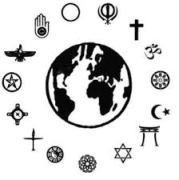
All these and more, please
However, the “religious pluralism” hypothesis was strongly supported. It is also interesting how Wortham defined religious pluralism; it was by the presence of a Christian church, a Jewish synagoge, a Gnostic church, or any combination thereof. Those had to be the indicators of pluralism since the world was generally polytheistic and temples to many Deities was the norm. It was the acceptance of monotheisms that proved pluralism.
Another factor was that these “religious marketplaces” were “deregulated” in that they were generally not controlled by the state and the people living there were open to, even hungry for, new spiritual opportunities; the market wasn’t “saturated,” so there was room for something new. Unmet religious needs existed.
The Isis-Christianity relationship was also highly supported. Wortham took note of the correlations between the Isis-Osiris-Horus death-rebirth myth and the Christos’ death-rebirth myth as well as the Madonna and Child imagery of both Isis worship and Christian worship. Since it is easier for people to accept new ideas if they are similar to old ideas, it is possible that the “cultural continuity” between Isiacism and Christianity may have aided in the spread of Christianity. These harmonies between the two spiritualities are still being discussed, debated, and making some people rather agitated even today.
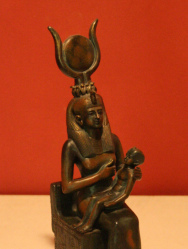
The Holy Mother & Her Holy Child
I must admit, knowing what eventually happened, I was a little saddened by learning that Isis may have paved the way for the religion that, wherever it spread, would eventually kill not only Her ancient worship, but that of all the Deities save the Christian one(s). A sociologist much discussed in Wortham’s study, Rodney Stark, concluded from his studies that when exclusive religious groups in a competitive free-market environment challenge non-exclusive religions, exclusive faiths eventually prevail.
But I don’t think exclusive vs. non-exclusive is the whole story. In terms of the rise of Christianity, exclusivity certainly made proselytizing simple, but it seems to me that the real key was Christianity’s rising political power. Once Constantine converted and started making anti-Pagan laws, it was all over. When your choice of Deity means you can be fined, excluded from the best jobs, especially political ones, have your property confiscated, and perhaps even forfeit your life, well, you’re kinda screwed. (No, I’m not forgetting Roman persecution of Christians. But the Romans were equal opportunity about it; they also persecuted Isiacs and Jews and Bacchants and I’m sure there were others.)
Religious freedom for all of us means we need the vibrant existence of many religions and many religious ideas in the “marketplace.” Frankly, I don’t know what the answer is when it comes to religions that insist that theirs is the one true way. How do we tolerate intolerance? How far can religious freedom go before it interferes with the liberties of others? But there is one thing that I do know: no religion—mine, yours, or anybody’s—should have the political wherewithal to enforce religious beliefs with actual laws. The separation of church and state is a vital, even if not always a perfectly realized and sometimes imperiled, concept.
Filed under: Goddess Isis Tagged: Goddess Isis, How the Isis religion spread, Isis, Isis and Christianity, Isis Magic, Pagan religious freedom, Religious freedom, Spread of cult








May 31, 2014
Isis-Bearing Names
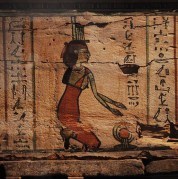
Isis on the coffin of Ankh-Wennefer, WA St. History Museum; photo by Joe Mabel, wikicommons
Let’s talk about theophoric names.
You may have spotted that “theophoric” is a Greek word; it means “Deity-bearing.” In other words, the name of a Deity is incorporated into the name of a human being. Isidora is an example. It means “Gift of Isis.” In the ancient world, a name like that would probably have meant that the parents credited the Goddess with helping them conceive, so the child was Her gift. Since for me Isidora is a “taken” name rather than a given one, I take it to mean that the Goddess has given me many gifts.
Of course, the simplest form of naming for the Goddess would be to just adopt Her name. There was at least one ancient Egyptian queen named Isis (Iset, in Egyptian), a queen mother named Isis, and a God’s Wife of Amun named Isis (who was also a royal princess). There may have been a whole slew of ordinary Egyptians so named, but alas, we have no records of them.
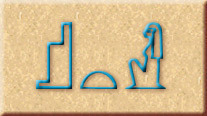
This is the most common hieroglypic writing of Isis’ name in Egyptian.
But for me, calling myself by Her name—without any modifications—would have made me squirm. (However, I admit I find it charming that some modern parents are once again naming their daughters Isis, though probably because they are giving them the name of a strong female figure rather than because they are devotees of Isis. But you never know. If you were born an Isis, hail and blessings to you, lucky girl!)
I recently came across a cache of other Isis-bearing names, some of which I’d like to share with you. They’re in Kockelmann’s Praising the Goddess. Rather than stringing you along for a paragraph or two, I want to cut right to the chase and tell you about the best Isiac theophoric name EVER.

The awesome scene from “The Mummy” when the statue of Isis raises the ankh to save Her reincarnated priestess from a lovestruck but murderous mummy
Why is it the best Isiac theophoric name ever? Well, I must digress for a moment to explain. Those of you who have been reading along may know that I have a thing for the original Boris Karloff Mummy movie. See here and here. (Oh, I know. Bad Egyptology, blah, blah, blah. Sorry, it’s awesome; it scared the ever-lovin’ b-jezus outta me as a kid, and Isis saves the day in the end. What more do you want?)
So in The Mummy, the name of the princess reincarnated in Helen Grosvenor (played by Zita Johann, who actually was something of an occultist) is Ankhesenamon (Ankh-es-en-Amon). That theophoric name means “She Lives for Amun.”
Well, we also have records of an Ankh-es-en-Iset: “She Lives for Isis.” Oh my Goddess! I think I’m going to have to adopt that as my super-secret Isiac name or something. Ankheseniset! Two of my favorite things have come together in one very magical name!
Whew. Calm down, girl. In fact, that’s not the only very cool Isophoric personal name of which we a record. Here are a few others that you may also enjoy:
Isetneferet (Iset-neferet)—”Isis is Beautiful”
Isetaneferet (Iset-ta-neferet)—”Isis the Beautiful”
Panehemiset (Pa-nehem-Iset)—”He Who is Saved by Isis”
Nehemsejiset (Nehem-sej-Iset)—”Isis Saved Her”
Isetweretayesnekht (Iset-Weret-tay-es-nekht)—”Great Isis is Her Strength” (Kockelmann gives it as “Isis the Great is Her Power”)
Tadjaisetankh (Ta-dja-Iset-ankh)—”Isis Gives Life”
Taheniset (Ta-hen-Iset)—”She Who is Entrusted to Isis”
Paremetiset (Pa-remet-Iset)—”The Man of Isis”
Taremetisest (Ta-remet-Iset)—”The Woman of Isis”
Paeniset (Pa-en-Iset)—”He is Isis’s” or “He Belongs to Isis”
Taeniset (Ta-en-Iset)—”She is Isis’s” or “She Belongs to Isis”
Saiset (Sa-Iset)—”Son of Isis”
Satiset (Sat-Iset)—”Daughter of Isis”
Khajiset (Khaj-Iset)—”Isis Appeared/May Isis Appear”
Isetemrenpy (Iset-em-renpy)—”Isis is Rejuvenation”
Isetiyet (Iset-iy-et)—”Isis Has Come”
Djediset (Djed-Iset)—”Isis Said” (perhaps a shortened form of “Isis Said: He Will Live” and referring to an ill child who recovered; I kinda like it as is, though)
And the Egyptian version of Isidora: Shepeniset (Shep-en-Iset)—”Gift of Isis”
Looking at these names, it won’t come as a surprise that Egyptians were big on shortening their names and calling each other by nicknames.
Of course, I’d never shorten Ankheseniset…

A regal-looking Isis by Russian artist Nicholas Burdykin. See more of his work here.
Filed under: Goddess Isis Tagged: Daughters of Isis, Gift of Isis, Goddess Isis, Isidora, Isis, Isis Magic,







May 24, 2014
Is Isis a Moon Goddess or a Sun Goddess?

A lovely painting of a lunar Isis by artist Katana Leigh. Visit her site here.
Modern Pagans often think of Isis as a Moon Goddess. And, it’s true, in later periods of Her worship, She was indeed associated with the Moon—and, in fact, that’s how She entered the Western Esoteric Tradition. The Isis-Moon connection first started when Egypt came under Greek rule in the 3rd century BCE, following the conquest by Alexander the Great. To the Greeks, Goddesses were the lunar Deities, so as Isis made Her way into Greek culture and hearts, Her new devotees naturally associated Her with the Moon.
In Egypt, Osiris, Khons, Thoth, and I’ah were the Deities most associated with the Moon. Isis, for Her part, was connected with the star Sirius as far back as the Pyramid Texts; the star was said to be Her ba, or soul. Yet Isis is also linked with the Sun.
As the Sun was the image of one of the most important Gods to the ancient Egyptians, it should not be surprising to find that Isis, one of the most important Goddesses, also has strong solar connections. In some places—notably, Her famous temple at Philae—Isis was worshipped specifically as a Sun Goddess. Among Her solar epithets are Female Re (Re-et) and Female Horus (Horet).
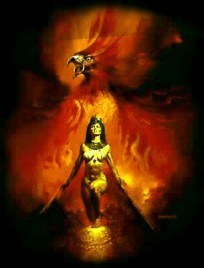
Phoenix by the famous illustrator Boris Vallejo; looks like a rather Isiac phoenix to me!
Isis’ most common solar manifestation is as the Eye of Re, the Uraeus, the Cobra Goddess Who coils upon the Sun God’s brow to protect Him; and Who fights a constant cosmic battle against His great opponent, Apop (Gr. Apophis). An inscription at Philae calls Isis “Neseret [fiery]-serpent on the head of Horus-Re, Eye of Re, the Unique Goddess, Uraeus.” A hymn from Philae calls Her “Eye of Re who has no equal in heaven and on earth.” The Eye of Re is His active power. While He maintains His place in the sky, the solar power—the Eye Goddess—goes forth to manifest His Divine will. In this way, Isis and the other Uraeus Goddesses (such as Nephthys, Wadjet, and Tefnut) are similar to Shakti, the active, feminine Power related to the God Shiva in some Hindu sects. Isis is also one of the Deities Who travels with Re in His solar barque as it moves through the Otherworld. Again, Her function is to protect Him and help battle His foes.
A vintage illustration of Isis learning the name of Re by H. m. Brock.
Isis is also associated with the Sun God and the Sun in several of Her important myths. In the tale of Isis and Re, Isis gains power equal to Re’s by learning His secret name, first by poisoning, then by healing the ailing God. In another, with Her magical Words of Power, Isis stops the Boat of the Sun in the sky in order to receive aid for Her poisoned child, Horus.
But it was at Isis’ influential temple at Philae that She was most clearly worshipped as a Sun Goddess and even as the Sun itself. A Philae hymn to Isis praises Her saying, “You are the one who rises and dispels darkness, shining when traversing the primeval ocean, the Brilliant One in the celestial waters, traveling in the barque of Re.” An inscription on the first pylon (gate) at Philae says Isis is the “One Who illumines the Two Lands with Her radiance, and fills the earth with gold-dust.” (I absolutely adore this praise of Her!)
Like many other Egyptian Deities, Isis was often envisioned with immortal, golden, solar skin. Some of Her sacred images would have been covered with gold, earning Her, like Hathor, the epithets The Gold and the Golden One. A Philae hymn addresses Her, “O Golden One; Re, the possessor of the Two Lands, will never be far from you.” Some scholars believe that the holy of holies at Philae may have once been gold-leafed so that it always appeared filled with golden, solar light. O how I would love to have seen that.

When NASA sends a probe to the sun, it will go in the name of Isis. Yes, this is the real mission logo. Check this link for the science and you’ll see that they indeed meant ISIS.
At Her Philae temple, Isis is first of those in heaven: “Hail to you, Isis, Great of Magic, eldest in the womb of her mother, Nuet, Mighty in Heaven Before Re.” She is the “Sun Goddess in the circuit of the sun disk” and Her radiance outshines even that of Re.
From Her great temple at Philae, Isis’ identity as a Sun Goddess flowed back up the Nile to Her temples at Memphis and Isiopolis in the delta. From there, it entered into the Graeco-Roman culture in the famous aretalogies (self-statements) of Isis. From a papyrus found in Oxyrhynchus, Egypt, we learn that one of Isis’ many names is Name of the Sun and that She is responsible for the rising of the Sun: “Thou [Isis] bringest the sun from rising unto setting, and all the Gods are glad.” In an aretalogy from Kyme, in modern Turkey, Isis says of Herself, “I ordered the course of the sun and the moon.” And later in the same text She says, “I am in the rays of the sun” and “I inspect the courses of the sun.”
Throughout Her worship, Isis has always shown Her life giving, fructifying power in the image of the Sun. She is the Radiant Goddess, the Lady of Sunlight.
Now enjoy this lovely animation of Isis birthing the Sun by Lesley Keen:
Filed under: Goddess Isis Tagged: Ancient Egypt, Aspects of Isis, Egypt, Goddess, Goddess Isis, Isis, Isis Magic, Isis Moon Goddess, Isis Sun Goddess, Isis worship today, Moon Goddess, Moon Goddess or Sun Goddess?, Pagan Spirituality, Sun Goddess








May 17, 2014
Red Isis

Oregon’s Painted Hills
I’ve just come back from the Red Land.
Not in Egypt, but in eastern Oregon. That’s my Red Land; just over the mountains from Portland.
The eastern Oregon desert is starkly impressive dressed in its iron-rust reds, dry-grass golds, basalt blacks, and pale, dusty sagebrush and juniper greens. And the Painted Hills! O my Goddess, beautiful, beautiful.
In honor of the Red Lands then, let us dive into the color red, its symbolism in ancient Egypt, and its relationship with Isis.
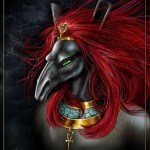
A modern rendition of fiery, red-headed Set
The ancient Egyptians had an interesting relationship with the color red, in Egyptian, desher. It was considered very powerful—in both a bad way and in a good way. The bad way connected red with danger, anger, and of course, the non-life-sustaining desert or desheret. (As you can see, our word for “desert” comes from ancient Egyptian desheret.) Red was associated with the red-haired and red-eyed God Set, a God Who can be angry, powerful, and destructive—as well as helpful and protective. In the magical papyri, you will sometimes see instructions that tell the magician to obtain a lamp “not colored red,” no doubt so as to not taint the magic with the negative aspects of the color red. The Egyptians described someone who was raging or furious as “red of heart.” Red ink would be used to write the names of dangerous creatures or Divinities in the temple scrolls. In the calendars that show lucky and unlucky days, the unlucky days were written in red ink, while the lucky ones were written in black.
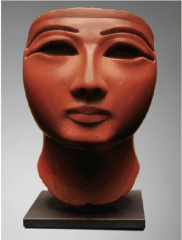
The head of a pharaoh carved of red jasper
On the other side of the ledger, red could also be associated with life, warmth, and protection, while still maintaining its ambiguous nature. Life-giving blood is red and connected with birth, rebirth, and regeneration, but it can also mean death if we lose too much of it. Warming and light-giving fire is red, but can be dangerous if uncontrolled. Red is the color of the radiant Sun God Re, but it was also the color of the Eye of Re, the Serpent Goddess Who could be either destructive or protective.
When it comes to Isis, we usually find red in its positive aspects. (Though it is true that the myths show that Isis can get a bit “red of heart” when it comes to protecting Horus’ interests.) Nevertheless, Isis is most often associated with red’s favorable characteristics: the promotion of life, protection, and regeneration.
Her famous amulet, the Knot of Isis or tiet, was usually made of red stone such as red jasper or red carnelian. In what I suspect is a modern legend—yet quite appropriate to the mythology of Isis—it is said that Isis wept tears of blood over the death of Osiris and these crystallized as carnelian. From them, the Goddess carved Her red tiet amulet.
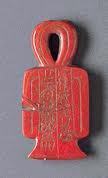
The classic red Knot of Isis
The tiet first appears in Egyptian iconography in the third dynasty. It was frequently used in association with the djed pillar of Osiris and so eventually became almost exclusively associated with Isis. Used together, the two symbols could refer to the power of the Goddess and God to engender Life. Because of this, the symbols may also be seen as sexual symbols; the pillar referring to the phallus of the God and the knot to the vulva and womb of the Goddess.
Once born, the new or renewed life would have to be protected, the perfect job for a magical knot. In fact, the formula to be spoken over an Isis Knot of red jasper connects the red of the amulet with the blood, power, and magic of the Goddess and is intended to protect the deceased during her or his transformation after death:
You have Your blood, O Isis. You have Your power, O Isis. You have Your magic, O Isis. This amulet is a protection for this Great One and which will drive away whoever would commit a crime against him.
—Formula 156, Book of the Dead
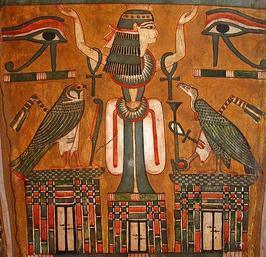
The Knot of Isis personified as a life-giving Goddess
You may recall that this amulet is also called the Blood of Isis and may represent the red lifeblood of birth or even red menstrual blood. Some say the amulet is shaped like the cloth worn by ancient Egyptian women during menstruation. Others have interpreted it as a representation of a ritual tampon that could be inserted in the vagina to prevent miscarriage. In this case, it would have been the amulet Isis used to protect Horus while He was still within Her womb.
In addition to Her red amulet, Isis is one of the Goddesses Who is the protective and powerful Eye of Re and we have already seen how Isis is associated with the redness of fire as well as the redness of a fierce nature. In a text from the Temple of the Birth of Isis at Hathor’s temple complex at Denderah, Isis unites the power, magic, and life-renewing qualities of the colors red and black in Herself for it is said that She was born “in the form of a black and ruddy woman, endowed with life, sweet of love.”
Red is the color of Isis’ distinctive, protective amulet. Red is the color of Her life-giving blood. Red is the color of Her powerful magic. Red is the color of the warmth, strength, and illumination of Her fire. Red is the color of the powerful, magical, fiery, life-giving Goddess Herself: Red Isis.
Filed under: Goddess Isis Tagged: Aspects of Isis, Desheret, Egypt, Egyptian magic, Goddess, Goddess Isis, Goddess worship, Isis, Isis Magic, Lady of Magic, Osiris, Set, Symbolism of the color red, The desert, The Red Land, Who is Isis?








May 10, 2014
Goddess in the Present Tense
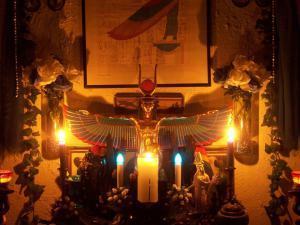
Someone’s beautiful Isis altar… if this is yours, please let me know. I love it!
If you’ve read Isis Magic and Offering to Isis, you may have noticed that—except when something actually is in the past—I always refer to the Goddess in present tense. In fact, I have been very, very, very, very conscious of doing so.
Because, you see, She IS.
She’s is not a Being Who was but is no more. She is not “just a myth,” some silly old story deserving of the past tense. Indeed, She is All that Was, and Is, and Ever Shall Be. She existed then, She exists now, and She will exist when the rugged, snowcapped mountain that, on a clear day, I can see from my rooftop has become a gentle, green hill.
And I know you know that. Which is why I am so puzzled when I sometimes see modern Pagans, Polytheists, Wiccans, and insert-your-self-definition-of-choice using the past tense about their Deities.
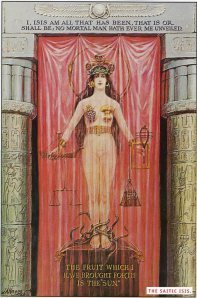
I am all that was, that is, that ever shall be…
It usually happens when telling Their sacred stories, trying to offer a brief “definition” of the Deity, or describing Their relationships with other Deities: “Isis was the Goddess of Magic.” Osiris was the husband of Isis.” Isn’t She still the Goddess of Magic? Isn’t He still Her husband? Now if you said, “To the ancient Egyptians, Isis was the Goddess of Magic and Osiris was Her husband,” that would work. No more ancient Egyptians around today, so what they considered is indeed history. To me, however, Isis IS the Goddess of Magic and Osiris IS Her beloved husband.
I may have had a tiny rant on this subject in Isis Magic:
In writing of the history of the Isis religion and the many aspects in which She has appeared to humanity, I have always kept in mind that, to the people who worshipped Her then, as well as to those of us who do so today, Isis was and is a Living Goddess. She is not a historical curiosity. She is not a metaphor for our times. She is not feminist wish fulfillment. She is not merely a psychological archetype. She is Divine Love, Life, Magic, Mystery. She is Goddess and She is.
And speaking of myths, a myth isn’t something that is false—”oh, that’s just a myth.” No. A myth is a sacred story meant to tell us something about the Deity or Deities of the myth. Myths are “things that never happened but always are,” in the words of the 4th century CE Roman writer Sallustius. Or maybe myths are things that never happened historically, but are eternally true. Or ask Joseph Campbell. Or Jean Huston. And remember, just because it belongs to the corpus of the dominant monotheisms doesn’t mean it’s not mythology. Egyptian mythology is. Christian mythology is. Jewish mythology is. They are all sacred stories and they are all mythology.
Okay. I’m done. Enough said. And may we all mind our tenses and our mythologies.

I kinda love this. Isis is a public dance party in San Francisco, mixed by the Bulgarian artist KINK.
The Is-ness of Isis
But how do we know that Isis is? How do we know that She’s “real”? Must we simply have faith? Do we just choose to “believe in” Her? Can we prove Her is-ness?
We can prove Isis’ is-ness, Her reality, exactly as much as any human being can prove the reality of any Deity, which is to say, we cannot. There is no scientific proof for the Divine. There is no infallible book that holds all the answers to all the questions. Yet this—happily—means exactly nothing when it comes to the truth of Isis’ existence.
This question of belief and faith is much more vexed for those of us in non-mainstream (O how I dislike that designation!) religions. How often have you been asked by some friend or family member or (hopefully) well-meaning stranger, “Well, then, what do Isians—or Pagans or Polytheists or Wiccans or insert-your-self-definition-of-choice—believe?”
And how have you answered?
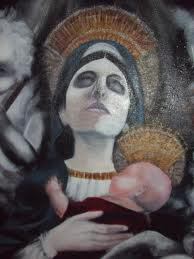
A powerful Madonna & Child
Many of us involved in alternative spirituality today were reared in one monotheistic religion or the other, most often, Christianity. From early on, we were taught to “believe in” God and Jesus. We were told that a particular book was the Word of God, “proved” that God was real, and explained precisely what He wanted us to do with our lives. In terms of religion, the clergy were to be our role models, the ones whose faith was strong, whose belief was true; we should have faith and believe as they do.
We got used to using those words, faith and belief, when speaking about religion. But perhaps those are not the right words.
For me, what proves that Isis is real is my experience of Her, not my faith or belief in Her. No single book is the touchstone for my spirituality, though I find spiritual truths in many, many books written by many, many wise human beings. I can’t transfer my deep knowing of Her reality to anyone else (though I do admit that the exercises and rituals in my books are attempts to at least set up the conditions that will enable others to open up to their own experiences of Her). Nevertheless, experience of the Divine is an individual thing; each one of us must experience Isis for ourselves—even if we do so in a group. Clergy can facilitate. Books can show us a way. The experiences of others can strengthen us in our desire for our own experience of the Goddess. But, in the end, we will not truly know Isis for ourselves until we have our own experience of Her.
When that experience comes for the first time, it may bring awe, tears, joy, pain. When it comes again and again, throughout the many years, I can tell you that it may still bring all those things. But repeated and ongoing experience of the Goddess will also bring a true knowing, a personal gnosis, of Her. No longer operating just “on faith,” now we know Her reality because we have experienced it. No longer just believing, we have discovered Her truth for ourselves and it has become our truth.

Yes, that’s it, Goddess, O yes!
Filed under: Goddess Isis Tagged: Aspects of Isis, Goddess, Goddess Isis, Goddess worship, Isis, Isis Magic, Isis worship today, Lady of Magic, Osiris, Pagan Spirituality, Priestess and Priest of Isis, The Goddess, Who is Isis?








May 3, 2014
Invoking Isis

I invoke Thee, Isis!
I adore invocation.
I remember the first time I invoked and really—really—felt Her presence, knew She was with me. Or with us, I should say because this particular invocation was with a small group here in town. I was pretty new at public invocation and I was pretty nervous.
I had memorized the invocation (highly recommended!) and when it came time, I spoke the words. The nervous energy became strength. The memorized words truly expressed my desire for Her. With each breath I drew in to begin each sentence of the invocation, I also drew in more of Her. And I could tell I wasn’t the only one feeling it. The entire circle began to psychically “buzz” as everyone awakened to Her growing presence.
That particular invocation stuck with me as you might imagine. I even included it in Isis Magic. It’s this one:
O Isis, Beautiful in All Thy Names,
I call Thee with the breath of my body,
I call Thee with the beat of my heart,
I call Thee with the pulse of my life,
I call Thee with the words of my mouth,
I call Thee with the thoughts of my mind.
I call Thee Power and Life and Creation.
I call Thee, Isis, Isis, Isis!

This is sort of what it feels like when invocation works.
Seems pretty simple, doesn’t it? It is. A good invocation doesn’t have to be complicated or long. On the other hand, sometimes long and complicated invocations are completely wonderful, providing us with the luxury of enough time to reach the right state of mind/soul.
The word invocation means “to call upon”. It’s originally from the Latin word invocare, but comes to us by way of late 15th century French envoquer. You’ll sometimes see the word used exclusively to mean calling a Deity or spirit into yourself (because of the “in” part of the word). While invocation can be used for that purpose, it doesn’t have to be.
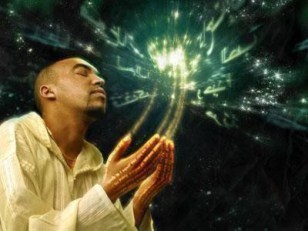
…and like this.
Invocation is a way to focus our intention and attention upon Isis. It offers a method for awakening and re-awakening in ourselves the knowledge of Her eternal presence. It opens a channel of communication and communion between us and Her. If we have done it well, invocation of Isis will evoke a corresponding emotion from us. When our defenses are down, our emotions are up, and we fully open our hearts and selves to Her, that’s when our invocations are effective and we find that She is fully present with us. And that is how the magic happens.
Invocation is a wonderful way to explore the many aspects of Isis. By invoking Her by Her various epithets (epithets are names or descriptive phrases that express various aspects or powers of the Goddess), we can experience and better understand the many facets of Isis’ nature.
To this end, I thought I’d share some of Isis’ many epithets, both well and lesser known, which you may wish to try out in your own invocations.
Great Goddess
Nutjeret Weret (Egy.); Thea Megiste (Gk.); Iset Weret (Egy.; “Isis the Great”). This is Isis in Her all-encompassing form as Goddess of All Things, and indeed, She is specifically called Lady of All. Other related epithets are Isis in All Her Names, Isis of Many Names and Many Forms, both of which refer to the ability of Her devotees to see Isis in all other Goddesses and all other Goddesses in Isis. At Denderah, She is called Lady of the Sky, the Earth, the Underworld, the Water, the Mountains, and the Nun (the Primordial Watery Abyss) for She is the Goddess of all manifest as well as all un-manifest things.
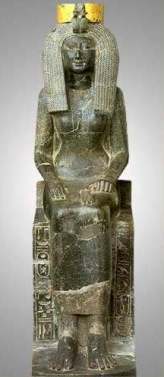
A noble and queenly Isis…who is actually an Egyptian nesutet named “Isis.”
Isis the Noble
Iset Shepshyt (Egy.). This is a very interesting one for me. Before I knew of this name, I had often described Her to myself as “noble.” Several other priestesses I know described Her that way as well. And then I learned that She was actually called “Noble” anciently as well. To me, She is somewhat aloof, yet entirely awe-inspiring, in this aspect. A related epithet is Isis, Lady of Dignity or Great of Dignity. At Isiopolis, there is an inscription that says that the Deities bow down before Isis’ dignity.
Isis the Queen
I just thought you’d like to have this word in Egyptian: Nesutet (“Queen”). This, of course, refers to Isis’ sovereignty over ancient Egypt. Yet as the Throne, Isis is Sovereignty Itself; She is the ruler and She confers rulership.
Beautiful Khabhuet
Khabhuet (Egy.; “Libationess”) is related to concepts like the Great Celestial Deep and the Watery Abyss. Thus this is Isis as the one Who makes effective—surely magical—libations and as a Goddess of the Primordial Depths.
Lady of the Journey on the Abaton
In an Egyption temple, the abaton is the sacred place where no one may walk, the Holy of Holies. As Isis is the Lady of the Journey on the Abaton, we may understand that She is so inherently holy that She may indeed walk there, or perhaps may even serve as our guide for such a journey; the shrine of Osiris on Biggeh, the island of Osiris’ tomb near Philae, was called the Abaton.

A Uraeus Serpent, one of the Divine forms in which Isis is sometimes depicted
Isis the Uraeus
Iset Uraiet (Egy.; “She Who Rears/Rises Up”). Uraeus is a Latinized version of the Greek word ouriaos, which is itself a version of the Egyptian word uraiet, which indicates the rearing, coiled cobra. The root word has to do with rising up or ascending, so that uraiet, a feminine word, can be interpreted as She Who Rears/Rises Up. The root word is also used to refer to the upward licking of flames. And indeed, the uraeus is often depicted spitting fire. This serpent fire represents both magical fire and the burning pain of the serpent’s venom.
In this form, Isis is the Cobra Goddess upon the brow of Re and His “Eye.” She is the Iret Eye (“the Doer”), the active power of Re. The idea is similar to Shakti, the active, feminine power related to the God Shiva in some Hindu sects.
Isis the Good North Wind
In different texts, Isis can be identified with various directions, but She has a strong identification with the north and the north wind. To understand, you have to know that to the ancient Egyptians, the north wind was the cooling, beneficial wind. It was thought that the north wind “dammed up” the Inundation, which flowed from the south, enabling the water to flood and nourish Egyptian fields. So Isis is not only the one Who heralds the Inundation and even causes it to flow (as Sopdet/Sirius), but also keeps it in place where it will fertilize the fields. She is called the Good North Wind and the Living North Wind.
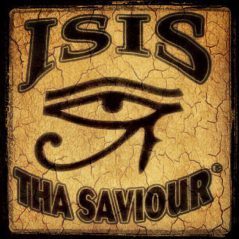
A hip-hop singer has taken up the Sotera name…
Isis the Savior
Even in Egyptian texts, we find Isis as a saving Goddess. She is the one Who dispels evils, storms, and “rescues the weak from the fierce.” When Isis moves into the wider Mediterranean world, we find Her called The Savior (Sotera, Gk.), All Savior or Savior of All (Pansotera, Gk.), and the Great Hope. She is both literal savior, helping and protecting people in their every day lives and She is the spiritual Savior, Who offers those who are Hers “a life given by grace” (Apuleius, Metamorphoses). The funerary inscription of a priest of Isis declares that because of the secret rites he performed during his life, he has traveled not to dark Acheron, but to the “harbor of the blessed.” The Goddess and Her Mysteries are a spiritual harbor in storm-tossed seas—an image that is still used today by devotees of the Christian Savior God.
Enough to chew on for now, I think. May your invocations of Isis in All Her Names be blessed.
Filed under: Goddess Isis Tagged: Ancient Egypt, Aspects of Isis, Egyptian Temples, Goddess, Goddess Isis, Goddess worship, Invocation, Invocation of Isis, Isis, Isis Magic, Priestess and Priest of Isis, Who is Isis?











